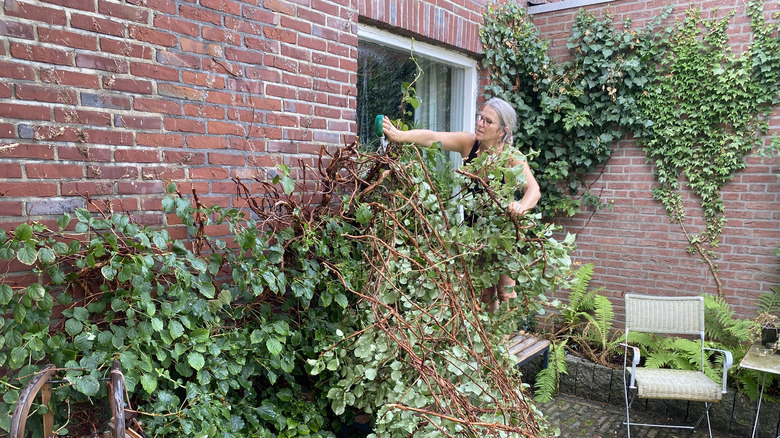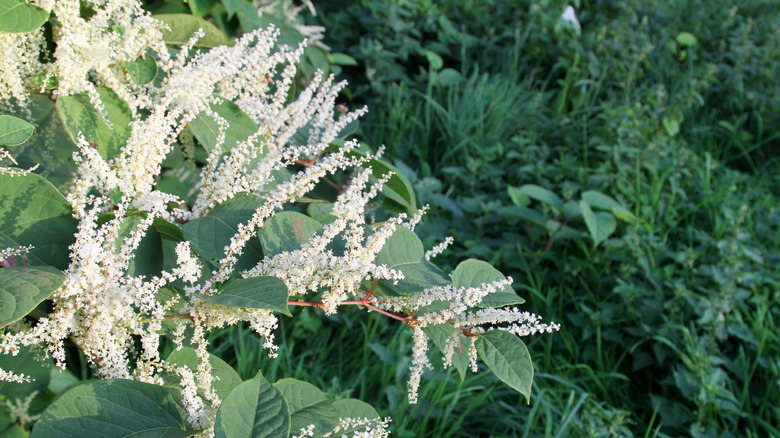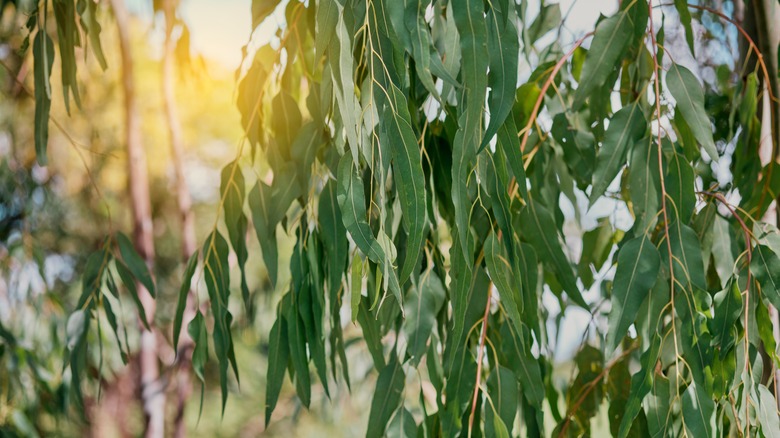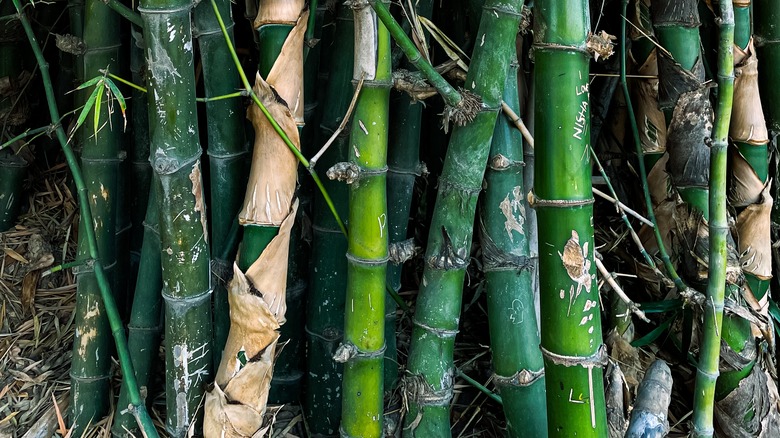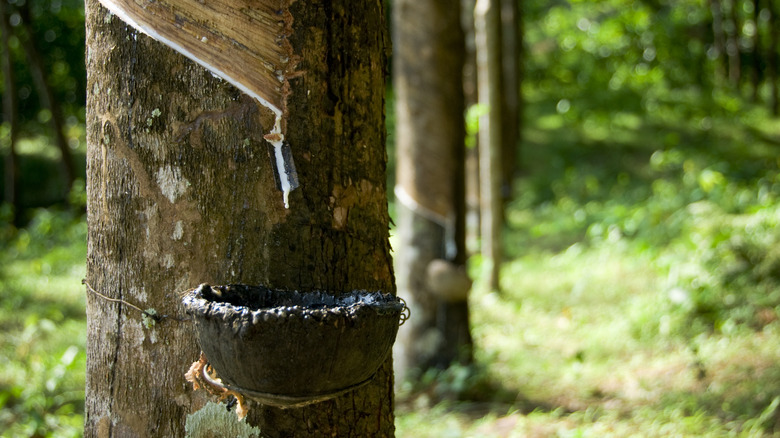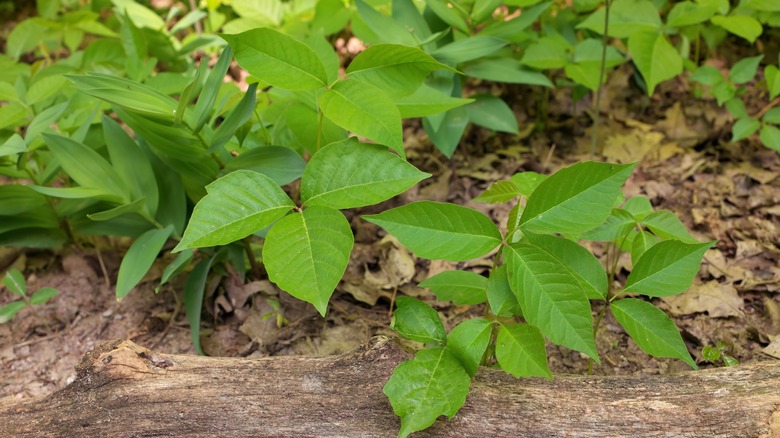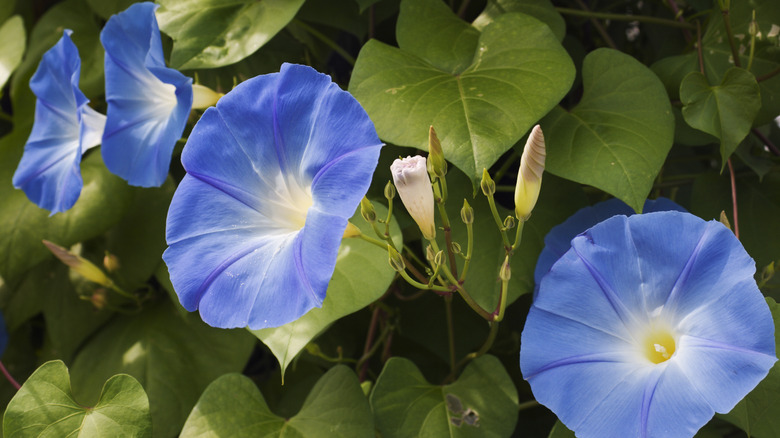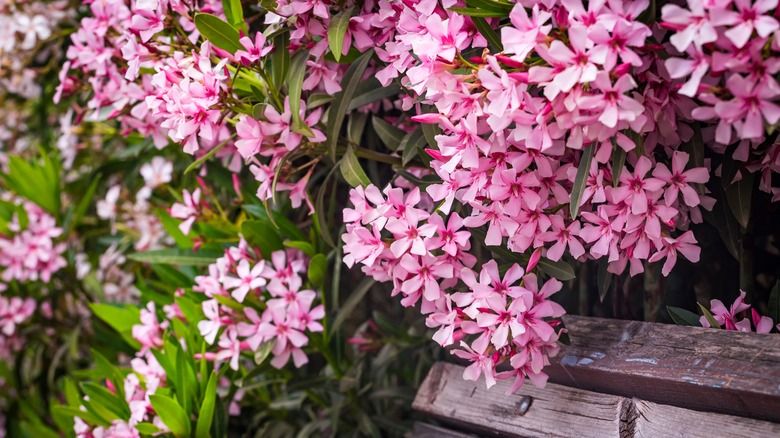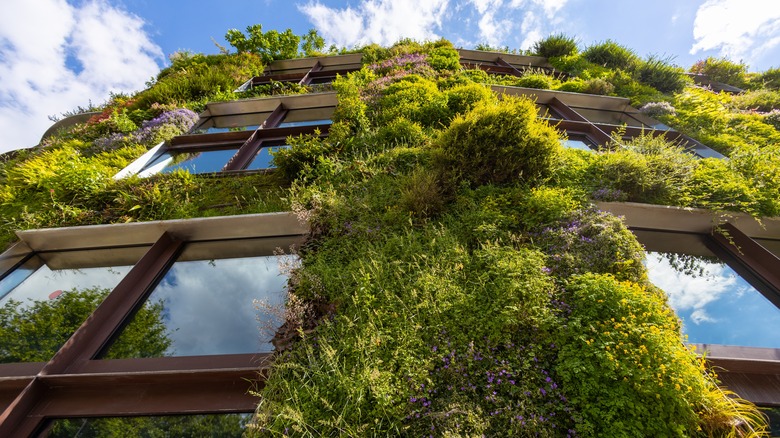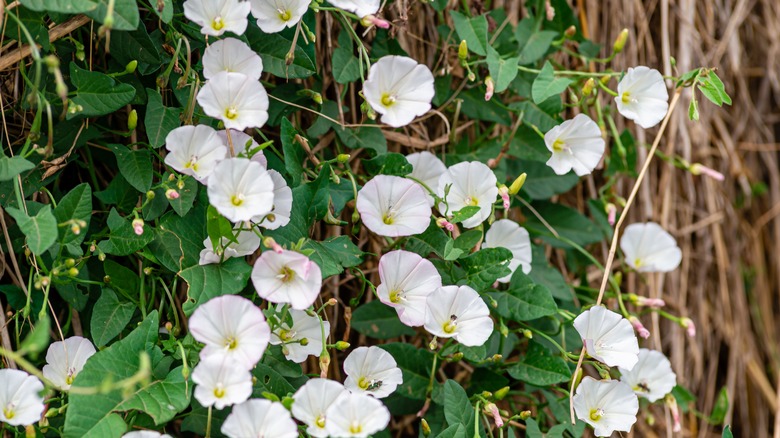Think Twice Before Growing Any Of These Plants Next To Your House
Welcome to the thrilling world of foliage, where each plant has its own tale to tell, and the garden becomes a stage for green theatrics. But, hold on to your gardening gloves! Not all botanical performers are eager to share the spotlight without some backstage drama. Today, we're spilling the beans on the flora that might bring unexpected twists to your gardening adventure.
Picture this: Japanese knotweed and bamboo staging a daring invasion, English Ivy and sweet autumn clematis plotting to take over your green kingdom, and creeping Jenny sneakily spreading gossip about its neighbors. It's a green soap opera, and your garden is the set! And, don't forget the native species trying to stand their ground amidst the chaos, only to find themselves caught in a conservation controversy. As if that's not enough, local zoning laws and homeowners' associations have rules which gatekeep which plants are allowed to be grown in home gardens.
To avoid unwanted disasters, we're shedding light on the potential threats that certain plants pose when planted near your house. So, pull up your gardening boots and arm yourself with knowledge that can save you from thousands in damage or medical bills.
Japanese Knotweed
Picture a plant with elegant, heart-shaped leaves and bamboo-like stems — a seemingly harmless addition to your garden, right? Unfortunately no. Japanese knotweed (Reynoutria japonica) can wreak havoc when planted in close proximity to your home, due to its aggressive and invasive growth habits (via KnotweedHelp). Its roots can delve deep into the ground, extending horizontally for several meters. This extensive network poses a significant threat to the foundations of your home. As it weaves through the soil, the plant's tenacious roots can exploit any existing cracks or weaknesses, exacerbating structural issues over time. Once Japanese knotweed takes root, traditional removal methods often prove ineffective, and even a small piece of rhizome left in the soil can regenerate into a new plant.
The consequences of Japanese knotweed's invasive nature translate into potential structural damage to your home. The force exerted by its roots can compromise building foundations, driveways, and even plumbing systems. The financial burden of repairing such damage can be substantial, making prevention crucial.
Despite these threats, some gardeners are drawn to Japanese knotweed for its ornamental appeal. In these cases, Gardening with Charlie Nardozzi recommends confining Japanese knotweed to large containers or raised beds. This approach limits its invasive tendencies, allowing you to enjoy its visual appeal without risking damage to your property. Alternatively, consult with a horticulturist or landscaping professional to assess your garden's layout. They can provide insights on how to integrate Japanese Knotweed in a controlled manner, minimizing the risks associated with its growth.
Eucalyptus
Eucalyptus trees (Eucalyptus spp.) are known for their distinctive fragrance and ethereal charm. However, the allure of these trees belies potential risks. One of the most significant concerns associated with Eucalyptus trees is their high flammability. Eucalyptus oil, present in their leaves, bark, and branches, is highly combustible, turning these trees into potential fire hazards, especially in regions prone to wildfires. The volatile oils can act as accelerants, increasing the intensity and speed of a fire.
In addition, eucalyptus trees are equipped with an aggressive and expansive root system that seeks water sources even in the driest of soils. This can lead to the depletion of moisture from the ground, potentially affecting the foundations of nearby structures — including houses. The rapid growth of eucalyptus trees can pose structural challenges for buildings and other nearby infrastructures. Their towering height and substantial weight may make them susceptible to toppling during storms or adverse weather conditions, risking damage to roofs, walls, or other structures.
If you still desire the beauty of eucalyptus, plant them at a safe distance from your home, according to Gardening Know How. This allows you to enjoy their visual appeal while minimizing the risks associated with their growth. If you reside in a wildfire-prone area, consider implementing firebreaks and incorporating fire-resistant plants in your landscaping design. Alternatively, opt for dwarf or smaller varieties of eucalyptus trees. These compact options retain the aromatic qualities without reaching the towering heights that pose structural challenges.
Bamboo
Imagine the serene rustling of bamboo leaves in the wind, creating an enchanting atmosphere in your garden. While bamboo (Phyllostachys spp.) can provide a lush and appealing aesthetic, it requires diligent maintenance to keep its growth in check. Without proper care and containment, bamboo can quickly become a landscaping nightmare, demanding more attention than some gardeners may be willing to invest.
Bamboo is a vigorous grower with an expansive root system that can extend far beyond its above-ground shoots. This relentless growth can lead to the plant encroaching on neighboring spaces, including your home (via Property Care Association). The underground rhizomes can be particularly invasive, causing issues with nearby structures, pathways, and even neighboring gardens. As the bamboo expands, it may exert pressure on walls, fences, and foundations, potentially causing damage over time. The forceful nature of its growth makes containment a crucial consideration.
Despite its potential challenges, bamboo continues to be a sought-after plant for its grace, versatility, and eco-friendly characteristics. Its rapid growth makes it an effective privacy screen, and its varied species offer diverse appearances, from delicate clumping varieties to stately timber bamboo. For those who appreciate bamboo's beauty but are wary of its invasive tendencies, Southern Living suggests installing root barriers to prevent the rhizomes from spreading uncontrollably. These barriers act as a physical deterrent, containing the growth and protecting nearby structures. Also consider clumping bamboo varieties, which are less invasive than running types. Clumping bamboo tends to grow in more contained, non-invasive clusters, making it a more manageable choice for smaller spaces.
Agave
The defining feature of Agave (Agave spp.) is its robust and sharp-edged leaves, often ending in formidable spines. These spikes can pose a threat to individuals, especially children and pets, who may come into accidental contact with the plant. Placing it near windows, walkways, or frequently used outdoor spaces may increase the likelihood of unintentional contact, posing a constant safety hazard.
Despite the potential risks associated with agave, it continues to be a popular choice for certain individuals due to its attractive qualities. Agave is renowned for its ability to thrive in arid conditions and periods of drought. For regions with water scarcity, the water-efficient nature of Agave makes it an appealing landscaping choice. Also, agave is relatively low-maintenance, requiring minimal care once established. Its adaptability and resilience make it an attractive option for those seeking an easy-to-manage garden element.
To avoid potential injuries or hazards, plant agave in containers or pots, allowing for mobility and control over its placement. This ensures that the plant can be positioned strategically, away from high-traffic areas. Or utilize Agave as part of landscaping borders or in areas where its spiky foliage doesn't pose a direct threat to human or pet traffic. This helps create visual interest without compromising safety.
Rubber Tree
Rubber trees (Ficus elastica) are known for their impressive size, with mature specimens often reaching considerable heights. When planted indoors, their towering stature can pose challenges to the structural integrity of your home. Over time, the weight of the plant and its expanding root system may exert pressure on containers or, in the case of in-ground planting, impact the surrounding structure, according to The Relining Company.
While rubber trees are relatively low-maintenance compared to some other large indoor plants, their size demands periodic care, including pruning and repotting. Neglecting these aspects can lead to overgrowth and potential difficulties in managing the plant's size within the confines of an indoor space. Indoor environments come with finite space constraints, and the expansive growth of a rubber tree may outgrow the available room. This not only affects the aesthetic appeal but may also lead to the plant encroaching on living areas, causing inconvenience to occupants.
To offset these challenges, Gardener's World recommends opting for compact or dwarf varieties of rubber trees that exhibit slower growth and maintain a more manageable size, making them suitable for indoor environments with limited space. Plant your rubber tree in a large container with wheels. This not only makes it easier to move for maintenance but also provides a level of containment, preventing the plant from outgrowing its designated space. As well, practice regular pruning to control the size and shape of the tree. This proactive approach helps maintain a balanced and visually appealing indoor environment.
Poison Ivy
Poison ivy (Toxicodendron radicans) stands as a paradox. Given its toxicity, one might question why anyone would entertain the idea of planting this notorious plant near their house. Uninformed individuals might be drawn to the aesthetics of poison ivy without recognizing the extent of its dangers. The plant can have an attractive appearance, especially during certain seasons, which could be seen as an asset. Some may plant poison ivy intentionally, thinking it could attract wildlife, The Advocate reports. In the opposite vein, some gardeners may even purposefully plant poison ivy as a way to deter intruders or trespassers. Unfortunately, any of these benefits are easily outweighed by poison ivy's cons.
The most notorious characteristic of poison ivy is its production of urushiol, an oil that induces severe allergic reactions in many people (via Mayo Clinic). Even the slightest contact with any part of the plant — leaves, stems, or roots — can result in skin irritation, rashes, and discomfort. The severity of the reaction varies from person to person, making it a substantial health risk. Poison ivy is not only hazardous upon direct contact but also possesses an alarming ability to spread rapidly. Its vines can climb walls, fences, and trees, infiltrating neighboring spaces and potentially causing exposure to unsuspecting passersby.
Once established, poison ivy can be challenging to eradicate. Its resilient nature allows it to thrive in diverse environments, resisting common removal methods. The persistent growth and difficulty in complete elimination make it a long-term threat to the surrounding landscape.
Sweet Autumn Clematis
Sweet autumn clematis (Clematis terniflora) consist of small fragrant white flowers with a vigorous climbing habit. They are a popular choice for those seeking a cascade of beauty in their garden. However, the charm of this flowering vine conceals potential challenges. Sweet autumn clematis is known for its rapid growth and robust climbing habit. While this makes it an effective choice for covering walls, trellises, and arbors, the unchecked growth can lead to the vine engulfing other plants and structures in its path. The strong, twining vines of sweet autumn clematis can cause pressure on fences, walls, and arbors. Over time, this can lead to damage, especially in regions with harsh weather conditions.
Despite the potential challenges associated with this flower, gardeners may plant it due to its elegant blooms, or its versatility in gardening structures. Also, the late-season blooming period of these blossoms contributes to garden interest during a time when many other plants may have finished flowering, extending the visual appeal well into the fall (via Fine Gardening). For gardeners seeking these benefits, explore native climbing plants as alternatives to sweet autumn clematis. Native species can provide similar aesthetic benefits while supporting local ecosystems and biodiversity. Otherwise, implement a consistent pruning routine to keep sweet autumn clematis in check. Regularly trim back the vines to prevent overgrowth and minimize the risk of structural damage.
Morning Glory
Morning glory (Ipomoea spp.) is often celebrated for its ability to add charm to any garden. However, the twining and climbing nature of morning glory can pose a risk to buildings, fences, and other structures. The vines may infiltrate small openings, causing damage to surfaces and creating maintenance challenges. The potential for structural harm increases when morning glory is allowed to grow unchecked. Morning glory produces copious amounts of seeds, and these seeds can be dispersed over a considerable distance. This makes it easy for the plant to establish itself in neighboring areas, potentially invading other gardens and natural habitats (via Wildwood Express).
To control the spread of these blossoms, Bob Vila suggests planting morning glory in containers or pots to restrict its growth and prevent the spread of its roots. This approach allows for easy control over its climbing tendencies and provides mobility. Implement a consistent pruning routine to keep morning glory in check. Regularly trimming back the vines helps prevent overgrowth and minimizes the risk of structural damage. Encourage morning glory to climb on trellises or arbors strategically placed away from structures. This not only adds vertical interest but also directs its growth in a controlled manner.
Oleander
Oleander (Nerium oleander), with its vibrant and fragrant clusters of flowers, has long been a favored ornamental shrub in gardens around the world. However, oleander is one of many plants that people don't know can be deadly. It is highly toxic, containing compounds known as cardiac glycosides that can be lethal if ingested (via ScienceDirect). Every part of the plant, including leaves, flowers, and stems, poses a risk, especially to curious children and pets. The toxicity extends to the plant's sap, making skin contact potentially harmful. Beyond direct contact, oleander releases toxins into the air. In regions where the shrub is prevalent, this may contribute to air pollution and pose health risks, particularly to individuals with respiratory conditions.
For those who appreciate the visual appeal of oleander but are concerned about its inherent risks, alternative planting solutions can offer a safer compromise. Opt for non-toxic flowering shrubs and plants that offer similar visual appeal without the associated dangers. There are many alternatives that can contribute to a beautiful garden without compromising safety. Or, if oleander must be included in the landscape, plant it in areas with restricted access, away from high-traffic zones frequented by children and pets. This helps minimize the risk of unintentional contact.
English Ivy
With its cascading vines and lush, evergreen leaves, English ivy (Hedera helix) is often chosen for its aesthetic appeal and ability to create a charming, natural backdrop. However, it is also known for its aggressive and invasive nature (via Royal Horticultural Society). Its vines can spread rapidly, climbing and covering structures, trees, and even the ground. This invasive behavior can lead to the displacement of native vegetation and may pose a threat to the health of established trees. The adhesive roots of English ivy enable it to cling to various surfaces, including buildings and walls. The persistent growth can lead to structural damage as it can even penetrate small openings, causing cracks and creating maintenance challenges.
English ivy's rapid growth can also result in the displacement of native plants, disrupting local ecosystems. This invasive tendency may contribute to the decline of biodiversity in the area, as English ivy competes for sunlight, water, and nutrients.
Despite the potential challenges associated with English ivy, individuals continue to be drawn to its visual appeal. It can climb walls, or drape elegantly from hanging baskets, offering a range of possibilities for garden design. Plus, the evergreen foliage of English ivy provides year-round visual interest, making it an attractive choice for those seeking greenery that remains vibrant even during colder seasons. For these gardeners, a consistent pruning routine will help to keep English Ivy in check.
Creeping Jenny
Creeping Jenny, scientifically known as Lysimachia nummularia, is a groundcover marvel celebrated for its vibrant yellow blooms and trailing growth habit. The name might give it away — this plant has a propensity to spread, and while it can be an enchanting addition to gardens, caution is essential. Its trailing stems can quickly form a dense mat, covering the ground and potentially outcompeting other plants in its vicinity. This vigor can make it challenging to contain within a designated area, leading to unintentional invasion of neighboring plantings.
Despite potential challenges, individuals are enticed to cultivate creeping Jenny for its small, bright yellow flowers that add a cheerful burst of color to gardens. Also, the trailing growth habit of creeping Jenny makes it an excellent choice for hanging baskets, containers, or as a groundcover for slopes. Its cascading stems create a visually appealing and dynamic landscape. Plus, creeping jenny is relatively low-maintenance, requiring minimal care once established. Its adaptability and resilience make it an attractive option for those seeking an easy-to-manage groundcover.
For those who appreciate the charm of creeping Jenny but are concerned about its potential invasiveness, Gardening Know How recommends digging up the plants before the flower, to prevent the spread of seeds. You can also use creeping Jenny as an edging or border plant in areas where containment is feasible. This helps define spaces and provides a visual impact without the risk of uncontrolled spread.
